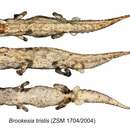en
names in breadcrumbs


Most individuals of B. tristis were found roosting at night on small branches about 5–50 cm above the leaf litter within a limestone massif with deciduous dry forest. By far most specimens were found in a few small areas where the species was abundant, whereas it was rare in other, apparently similar habitats. One of the females laid two large eggs (5.9×3.7 mm resp. 5.8×3.5 mm diameter) in February. The two juveniles hatched 64 and 69 days after egg deposition at temperatures between 20–26°C. They measured 14 mm in total length. Eight days after hatching the weight of the older juvenile was 0.03 g.
A member of the Brookesia minima group based on small body size (SVL <24 mm) and molecular phylogenetic relationships. Brookesia tristis is distinguished from other members of the group as follows: from B. dentata by probably smaller adult body size (no measurements of male B. dentata available), and presence (in most specimens) of lateral spines on the tail (vs. absence); from B. exarmata by presence (in most specimens) of lateral spines on the tail (vs. absence); from B. karchei by probably smaller adult body size (female SVL 18.0–23.8 mm vs. 30.7 mm; no measurements of clearly identified males available for B. karchei), and absence of a supraocular cone (vs. presence); from B. minima by the presence of a supranasal cone, a pelvic spine, and (in most specimens) lateral spines on the tail (vs. absence), and hemipenis with small apical spine-like papillae (vs. balloon-like without ornaments); from B. peyrierasi by smaller adult body size (male SVL 18.0–18.2 mm vs. 19.7–22.4 mm), presence (in most specimens) of lateral spines on the tail (vs. absence), and by a hemipenis with small apical spine-like papillae (vs. bilobed hemipenis with four large spines per lobe); from B. ramanantsoai by smaller adult body size (male SVL 18.0–18.2 mm vs. 21.7 mm), absence of a supraocular cone (vs. presence in some specimens), presence (in most specimens) of lateral spines on the tail (vs. absence), and hemipenis with small apical spine-like papillae (vs. hemipenis balloon-like without ornaments); and from B. tuberculata by the absence of a supraocular cone (vs. presence), presence (in most specimens) of lateral spines on the tail (vs. absence), and hemipenis with small apical spine-like papillae (vs. hemipenis with apical crown-like structure). For a distinction from B. confidens, B. desperata, and B. micra, described below, see the diagnoses of these species. Referencing a fragment of the 16S rRNA gene, B. tristis shows an uncorrected pairwise divergence of 6.4% to its sister species B. desperata, and divergences >6.9% to all other species of the B. minima group.
The species epithet is an adjective derived from the Latin “tristis” meaning “doleful”, “sad”, “sorrowful”, and refers to the fact that the entire known range of this species (Montagne des Français) suffers from severe deforestation and habitat destruction [D'Cruze N, Sabel J, Green K, Dawson J, Gardner C, et al. (2007)] despite recently being declared as a nature reserve.
Brookesia tristis is a species of chameleons. It is endemic to Montagne des Français, Madagascar, and is an endangered species due to the decline of its habitat.[1] It was named after the French word "triste" meaning sad to provoke thought regarding the threatened habitat of Madagascar's micro-endemic species. B. Triste was first found in an isolated patch of forest near an expanding city in 2012 by a research team led by Dr. Frank Glaw from the Zoologische Staatssammlung München.[2]
Brookesia tristis is a species of chameleons. It is endemic to Montagne des Français, Madagascar, and is an endangered species due to the decline of its habitat. It was named after the French word "triste" meaning sad to provoke thought regarding the threatened habitat of Madagascar's micro-endemic species. B. Triste was first found in an isolated patch of forest near an expanding city in 2012 by a research team led by Dr. Frank Glaw from the Zoologische Staatssammlung München.